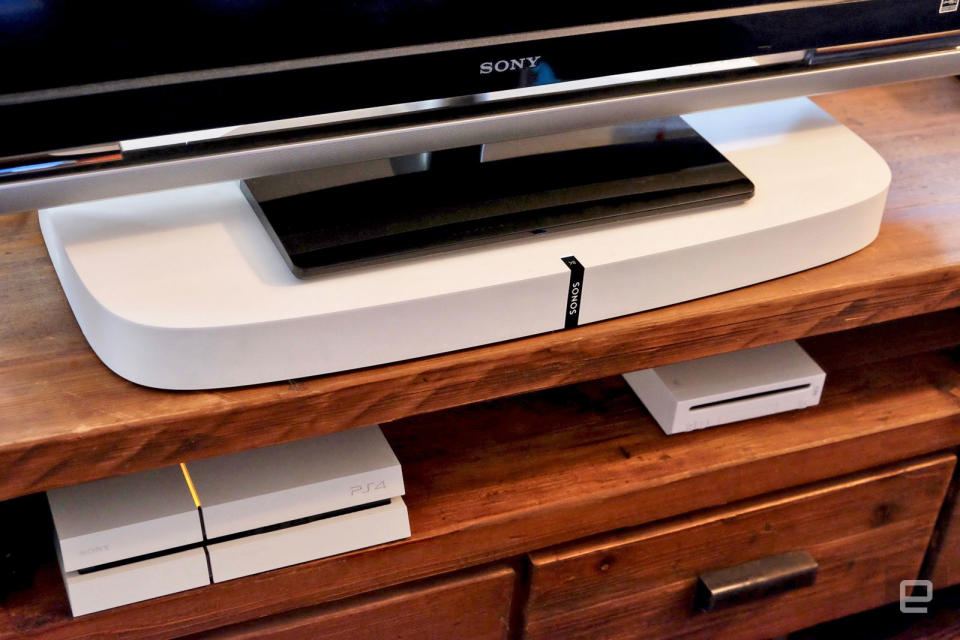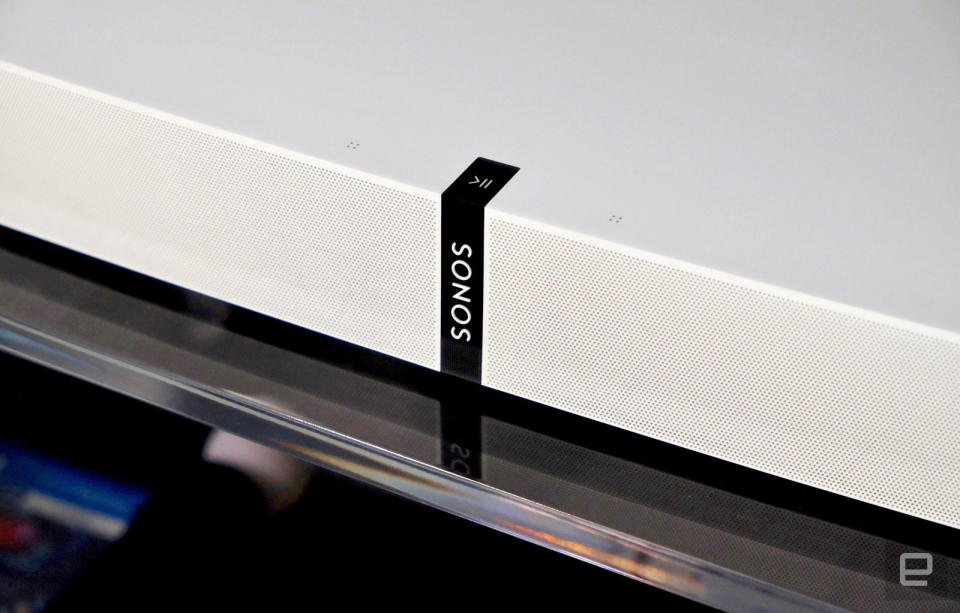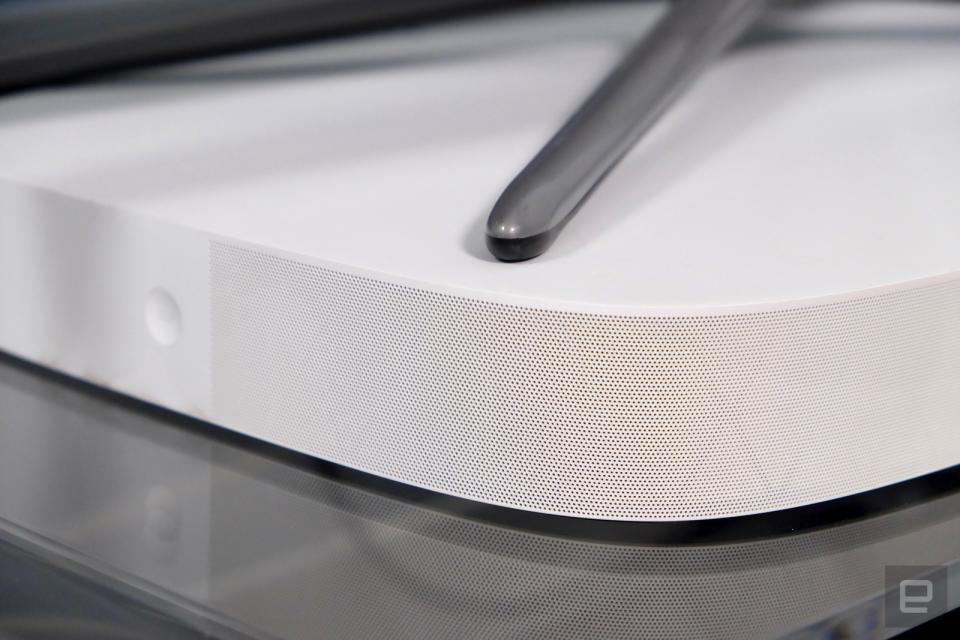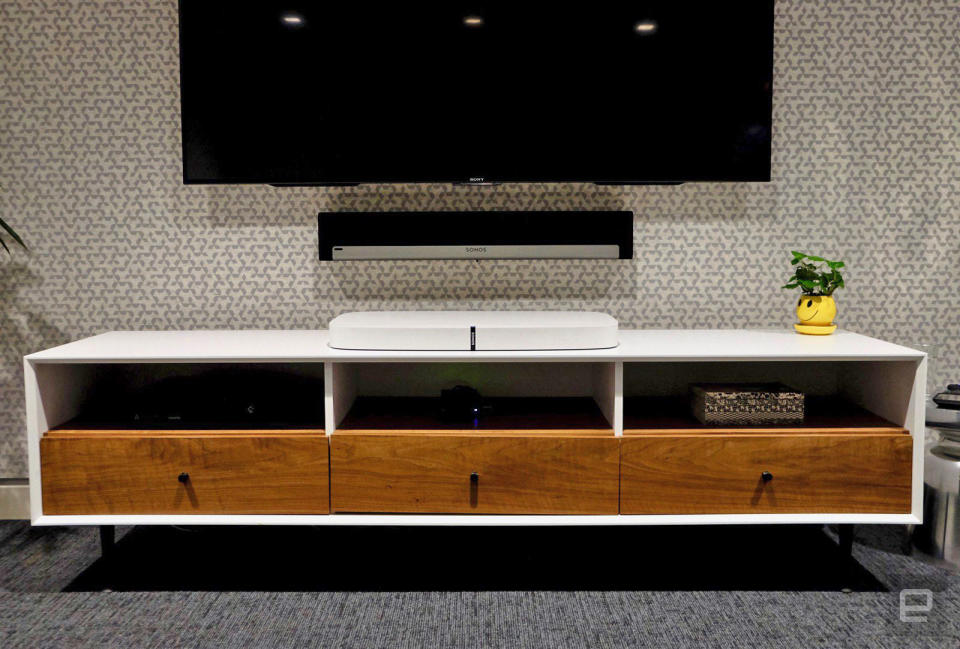Sonos Playbase review: The only speaker your living room needs
This oddly shaped speaker is a double threat, equally suited to playing music and movies.

The idea of having high-quality home theater audio seems great until you actually try and set it up. I've owned a few surround sound systems, but the additional speakers and cables added a level of complexity that never felt worth it to me. So I've been languishing for years with mediocre audio coming from my built-in TV speakers. It doesn't sound great, but at least I have a clean setup that doesn't require extra hardware and a mess of cables.
But the Sonos Playbase has me thinking that it's time to upgrade. This massive speaker, wide and flat like a pizza box, is designed to sit underneath your TV, and includes three distinct audio channels as well as a built-in subwoofer. Like all other Sonos products, it uses WiFi to connect to other speakers and lets you stream music from just about any service you can think of, but it also outputs all of your TV audio. Sure, it's not a full 5.1 setup, but a one-box, one-cord solution to upgrade my home theater seems like just what I need. Still, as with almost everything Sonos does, it doesn't come cheap: $700 in this case. For those who want better sound in their living room, the Playbase is a compelling option -- particularly if you're a music fan.
Hardware

The Playbase has an unusual shape compared with most speakers, but there's a clear reason for this odd design: It's meant to sit on a media stand with a TV on top. Sonos says the device can support most televisions up to 60 inches or up to 77 pounds. Bigger sets that have stands with legs on either side can usually be placed over the Playbase as well. Of course, it can be used with wall-mounted TVs too, but one of the speaker's main selling points is that it can bear the weight of a television on top of it without an impact on audio quality. Indeed, Sonos claims that its research shows that 70 percent of TV owners never mount their TVs to the wall; if that's true, there's a lot of people who could use a speaker like the Playbase.
Like Sonos' last speaker, the Play:5, the Playbase is a simple, sleek thing that shows great attention to detail. Yes, it's a big plastic box, but the soft-touch finish feels extremely durable, not to mention pleasant underneath your fingers. That's good, because there are a few touch-sensitive controls right near the front of the speaker. Other examples of the Playbase's refined fit and finish include the CNC-drilled holes on the front face. Sonos specifically picked that pattern to minimize visual distraction without affecting sound quality. There's only so much to say about a giant white box (it also comes in black), but it exudes polish and quality -- something you definitely want from a $700 product.
All told, it's an exceedingly simple device. There are those touch-sensitive controls on the front of the speaker. Tapping above the Sonos logo will play or pause music, while tapping to the left or right will decrease or increase volume. And you can swipe left to right to go forward in your playlist; swiping in the other direction goes back a track. These are the same controls that Sonos included on the Play:5, and they're equally welcome here. The only other button is on the left side of the Playbase; you press it during setup to get the speaker connected to your WiFi network (more on setup in a moment). Around back are ports for power, Ethernet and optical audio. That's it.

Our test TV left some ugly scrapes on the Playbase's white finish.
The Playbase did let me down in one big way. As I was setting up my review unit, I somehow managed to put a few scuffs and scrapes on the otherwise pristine white surface. I wasn't really able to get them out either. While I haven't noticed them since setting up the speaker, as they're mostly covered by my TV, I was still disheartened to discover that I was able to mark up such a lovely device so easily. If you're the type of person who moves a lot or is a bit harder on your belongings, you might be better off with the black version. In my case, though, the white speaker looks great alongside my white PS4, those marks notwithstanding.
Setup
The Playbase's simplicity extends to the setup too. Once I placed the speaker under my TV, I plugged it into the wall and hooked it up with the included optical audio cable. The Sonos iOS app then walked me through everything I needed to do. (There's an Android application as well.) Setup was a little easier, since I already had Sonos speakers in my house, which means I already have a Sonos account. Even so, starting from scratch is simple enough. The Sonos app scans and finds nearby speakers and connects them to the WiFi network your mobile device is on. All I had to do was follow the app's directions and press the button on the side of the speaker to connect it and it was basically good to go. You'll also likely need to switch your TV's setting to output audio to an external device rather than its built-in speaker.
The Playbase uses the same "Trueplay" room-tuning technology that Sonos introduced alongside the Play:5 in late 2015. If you haven't used it before, Trueplay basically adjusts the audio characteristics of Sonos' speakers to make them sound as good as possible, regardless of where they're placed in a room. The process is slightly different when tuning the Playbase, because the speaker is meant for both music and movies.
First, the app asks you to sit where you'll most often watch TV, and then you'll walk around the room to tune the speaker for music playback. It takes a bit longer, but it's still super easy and can make a noticeable difference. I didn't notice a big change with Trueplay turned on or off, but your mileage will vary based on your particular room. One downside: Trueplay still requires an iOS device. The company says that the huge variety and variability of microphones found in Android phones make it too difficult to tune speakers reliably. That's not to say the speaker sounds bad without it, though; indeed, I wouldn't call this a deal-breaker for households without an iDevice.
Movies and TV

Now we're on to the best part about testing this speaker: sitting back and watching a lot of TV. For my tests, I streamed movies and shows from Netflix, Hulu and iTunes via my Apple TV, and I also watched some movies on Blu-ray through my PS4. Regardless of the source, the Playbase was an immediate and massive upgrade over my TV's built-in speakers.
The subwoofer that Sonos managed to cram into the Playbase provided the most significant upgrade. Explosions in Star Wars: The Force Awakens, Interstellar and Inception all delivered room-rumbling bass that a TV simply can't provide on its own. The impact of the subwoofer isn't limited to things blowing up, either. When Sauron was temporarily vanquished in the prologue of Lord of the Rings: The Fellowship of the Ring, his helmet hit the ground with startling force.
While epic moments in big films are a great showcase for the Playbase, that's not the only place where it shines. When Sonos first unveiled the speaker, company execs talked about the importance of delivering super-clear dialogue. Indeed, the Playbase delivers that in spades. A speaker of this caliber simply makes everything sound more "present" -- like the characters are right in the room with you. Big bass may turn heads, but crystal-clear dialogue is something you'll appreciate every single day, regardless of what you're watching.
Even sitcoms like Parks and Recreation and The Office sounded noticeably better than when I watched with standard TV speakers. One Parks and Rec scene featured a character speaking to a crowd through a megaphone, and I could hear the scratchy, amplified characteristics of that speech in a way I wouldn't have noticed on lesser speakers. And, as silly as it sounds, the theme song for The Office has never sounded so good.
Speaking of music, film scores sound excellent as well. They generally take a backseat to dialogue and sound effects, but hearing John Williams', Hans Zimmer's and Howard Shore's epic musical landscapes blasting forth with tremendous depth was almost as much fun as the big explosions. Inception was another great test for the speaker: The trademark two-hit musical cue blared forth like a siren, and the movie's excellent closing sequence and accompanying score hit hard.
As with the Play:5, the area where the Playbase shows some weakness is in stereo separation. That's not to say you don't get any stereo effects here. Ships and laser blasts in The Force Awakens panned across the soundscape as they did on-screen -- just not with the same dramatic effect that you'd get from a multi-speaker setup. It's still a clear upgrade from the internal speakers that I'm used to, but it doesn't quite hit the theatrical level of immersion you'll get with dedicated left, right and center speakers.
While I didn't get to test this out, it's worth noting that the Playbase lets you wirelessly sync with the Sonos Sub and two Play:1 speakers to build a 5.1 surround sound setup out of four wireless speakers. And if the internal subwoofer is enough for you, you can also just use the Playbase with the two Play:1 speakers for a cheaper and less complex setup. As someone with surround sound ambitions, the idea of using the Play:1 as wireless back speakers is extremely compelling, if not super affordable; those speakers cost $200 each, while the Sub alone commands a cool $700. For me, the internal sub was more than sufficient, so I don't plan on shelling out for a dedicated unit anytime soon.
Music

If you've been using Sonos for a while, it's likely been for tunes: The company was one of the first to make it easy to stream music to high-quality speakers. (If you haven't used Sonos much before, our Play:5 review offers a great overview of how its wireless music streaming system works.) So while the Playbase was designed with home theater in mind, it has to perform when playing back music as well. Fortunately, music playback is outstanding. Unscientifically, I'll say it sounds nearly as good as a single Play:5 speaker, and it absolutely smokes the smaller Play:1 I have in my living room when it comes to clarity and volume.
Though the Playbase's stereo performance while watching movies didn't exactly blow me away, it actually sounds excellent here. I listened to a wide variety of songs I know inside and out and still managed to experience the music in a fresh way, thanks to some dramatic stereo panning. Vocals were clear and detailed, on par with dialogue in movies and TV shows.
For most people looking for a dedicated audio speaker, they'd probably do better with a Play:5; it's fantastic and $200 cheaper. But the versatility of the Playbase is a huge point in its favor. If I had to choose between a $500 Play:5 and a $700 Playbase for my living room, I'd probably get the Playbase. It gives up very little in terms of audio quality compared with the Play:5 and feels like a huge upgrade when you're watching movies and TV shows.
The competition

The Sonos Playbase, pictured here below the Sonos Playbar mounted to the wall.
Sonos has played up the Playbase's rather unique form factor, but there are other speaker bases on the market. The $300 ZVOX 570 sits under your TV and has a built-in subwoofer, just like the Playbase. The $379 Bose Solo 15 Series II doesn't have a sub, but it does include Bose's "Truespace" technology, which works with the center speaker to enhance dialogue. JBL's $230 Cinema Base also has built-in subwoofers. Of course, none of these speakers have Sonos' streaming capabilities, though you can send audio to all of them over Bluetooth. Finally, none of them offer the ability to build a wireless 5.1 setup with other Sonos speakers. On the other hand, these speakers all cost less than half what you'll pay for the Playbase.
If you don't need your speaker to double as a stand, Sonos' own Playbar offers a similar feature set (minus the subwoofer) for the same $700 price as the Playbase. And if you look beyond Sonos, there's a veritable flood of soundbars available from major home audio companies like Sony, Vizio, Yamaha, Samsung, Denon and Paradigm, among others. You can spend a lot less than you would on the Playbase, or spend much, much more, depending on your proclivities.
Wrap-up

As I noted earlier, the Playbase is an extremely compelling one-speaker option for the living room, particularly if you're a music fan. It's easy to set up and adds very little complexity to most TV rigs; not having to run lots of cords is a huge win in my eyes. And once you're set up, it simply makes watching movies a lot more fun, whether they're big-budget action flicks or quiet, hushed dramas. Either way, dialogue sounds great. And its music performance is outstanding. It's not quite as good as Sonos' own Play:5, but the versatility of having one speaker that works great for both TV and music is hard to top.
Of course, at $700, it had better hit all these marks. In a vacuum, that's a lot of money to spend on a speaker, particularly if you're someone like me who's been content enough to live with boring built-in TV speakers. And there are many less expensive soundbars you could buy to improve your TV audio. On the other hand, the Playbase's versatility between music and movies is unmatched, making for a speaker I would use nearly every single day. It's great for watching TV on weeknights, or movies on the weekends, and for playing music anytime I want.
SaveSave











